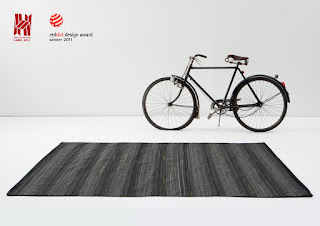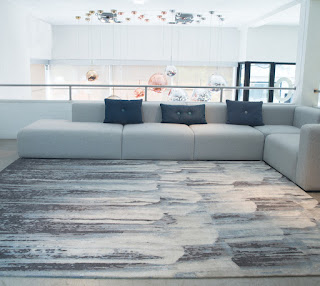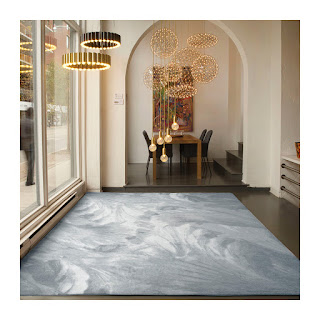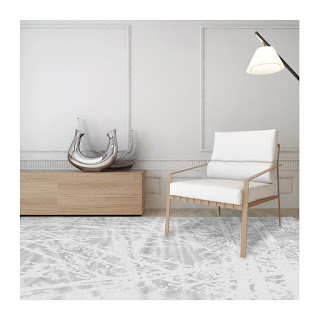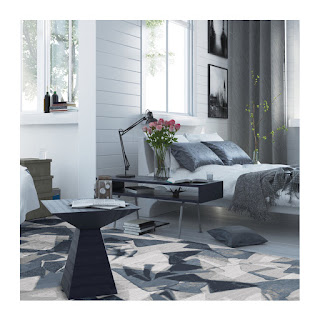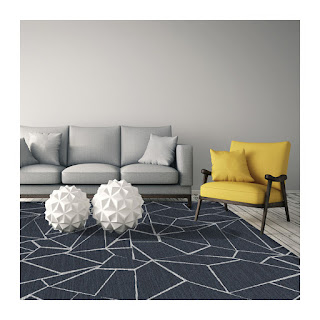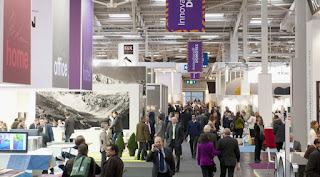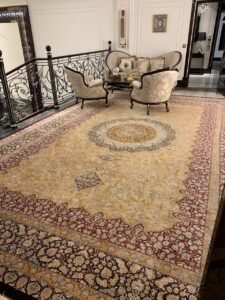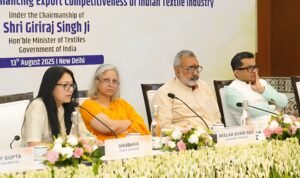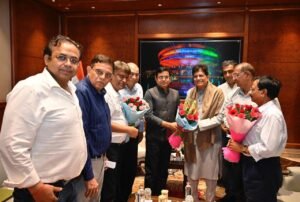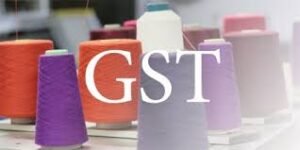domotex top most selected design
Beauty
Best Studio Artist Design: Ayka Design (Hall 17, Stand D34). The sensuous pose of the young girl in this rug, which is made from hand-spun silk and features 110 Tibetan knots per square inch, is undercut by the restless energy of the varying pile lengths and by the idiosyncratic, abstract coloration.
Re Orient
Best Studio Artist Design: Studio Brieditis & Evans. A hand-crocheted rug made from discarded T-shirts, utilizing ancient craft techniques – revived here by the Swedish textile artists Katarina Evans and Katarina Brieditis. The colour palette is inspired by Oriental pieces and traditional Swedish “Röllakan” rugs.–
Re Rag Rug Squeeze Me Hold Me
 Best Studio Artist Design: Studio Brieditis & Evans. A rug that flows through the room and over furniture: Katarina Evans and Katarina Brieditis have created an extraordinary rug, hand-knitted from recycled jersey yarns, with a beguilingly textured – and reversible – weave in black and white. Size: approx. 130 × 170 cm.
Best Studio Artist Design: Studio Brieditis & Evans. A rug that flows through the room and over furniture: Katarina Evans and Katarina Brieditis have created an extraordinary rug, hand-knitted from recycled jersey yarns, with a beguilingly textured – and reversible – weave in black and white. Size: approx. 130 × 170 cm.Emerald 1
Best Modern Design Superior: Art Resources (Hall 17, Stand D43/1). A mystical forest, with an intricate design of tall, slender-limbed trees whose leaves shimmer in gradations of pale yellow. This rug from US-based Art Resources is a new addition to its “Emerald” collection, inspired by nature. Hand-knotted in wool, silk and cotton.
Crystallize – Ice
Best Modern Design Superior: Creative Matters (Hall 17, Stand E53/1). Frost on window panes was the inspiration for the intricate motif in soft white and grey tones. Knotted in Tibetan wool and Chinese silk (20 per cent), with 100 knots per square inch, the rug has a delicate, fluffy texture and a pile length of four millimetres.
Aleph
Best Modern Design Superior: Naziri (Hall 17, Stand E29). Minimalist design as the emblem of modernism? The archaic stripes on this woven rug have their origin in Persian mysticism of the 12th century, when keeping things simple was a virtue. The flatweave rug is woven from goats’ and sheeps’ wool in Iran’s Zagros Mountains. Exhibitor detail
Best Modern Design Deluxe: Chevalier Édition (Hall 17, Stand E43/1). Is that the strangled, throaty voice of the trumpet we hear, the enigmatic twanging of the harp, and the rhythmic pounding of the piano keys, when we look at this rug? Making jazz music into a rug is no mean feat, but the interior designer Bruno Moinard has managed it.
Electric Taupe
Best Modern Design Deluxe: Hossein Rezvani (Hall 17, Stand D43). It’s a challenge to get a modern carpet design hand-made in Persia to the finest standards of traditional craftsmanship. Hossein Rezvani translates classic designs into a contemporary idiom by deconstructing the motifs and reinterpreting them in fresh colours – without denying their origin.
Taittu / Free Verse-Kollektion
Best Modern Design Deluxe: Jaipur Rugs (Hall 17, Stand D36). Impeccable design, perfectly realized with digital technology, or craft skills that make every piece an individual work of art – these hand-knotted rugs bridge the gap between technology and tradition with exciting designs that reference both.
Suzani
Best Traditional Design: Wool and Silk Rugs (Hall 17, Stand B54/2). The traditional Suzani design is reminiscent of the hand-embroidered textiles that form part of the dowry of Usbek brides. The rich colours and fine detailing make this hand-knotted rug from Afghanistan a true work of art.
Marta Stripe
Best Traditional Design: Rug and Kilim (Hall 17, Stand C29). A homage to the Swedish artist Märta Måås-Fjetterström, who opened her workshop in Båstad in 1919, and soon afterwards showed her carpet weaving work at New York’s MoMA: flat-woven, in the style of Swedish folk art, and vigorously geometric in design.
Yildiz
Best Traditional Design: Öz-Kent Hali (Hall 17, Stand B49). Inspired by a Turkish Ushak rug from the 16th century, which can be seen in Berlin’s Pergamon Museum, this specimen in the style of a prayer mat is notable for its bold juxtaposition of contrasting reds and blacks and its Oriental dragon and flower motifs.
Reflection
Best Transitional Design: Choudhary Exports (Hall 17, Stand D21). Echoes of the legendary Gobelins from the French village of Aubusson, which were made there in the 17th and 18th centuries, are revived in this rug: made from hand-spun silk and double-twist wool yarns, the design seems almost like a hybrid of two different pieces.
Persy
 Best Transitional Design: Chevalier Édition (Hall 17, Stand E43/1). Designer Samuel Accoceberry deconstructs traditional patterns and turns them into small geometric motifs, which are then given added emphasis by the use of different pile lengths. The collection includes rectangular and round rugs, all in tone-on-tone colourways.
Best Transitional Design: Chevalier Édition (Hall 17, Stand E43/1). Designer Samuel Accoceberry deconstructs traditional patterns and turns them into small geometric motifs, which are then given added emphasis by the use of different pile lengths. The collection includes rectangular and round rugs, all in tone-on-tone colourways.Secret Garden
Best Transitional Design: Naziri (Hall 17, Stand E29). Elaborately designed gardens are seen in Persia as spiritual places, which are close to paradise and conducive to relaxation. Such a garden, surrounded by water, runs like a straight path down the rug, which is made from 100 per cent highland wool, hand-spun and vegetable-dyed.
Origami
Best Modern Collection: Ayka Design (Hall 17, Stand D34). Referencing both traditional and contemporary textile textures, this motif, with its intricate crosshatching in tonal colour gradations and different pile lengths, invites the eye to range and wander. Exquisitely crafted from hand-spun silk, dip-dyed, with 110 knots per square inch.
Landscape Collection
Best Modern Collection: Wool and Silk (Hall 17, Stand B54/2). With a little imagination, it is possible to discern a snow fox padding through the reed-like vegetation: rugs that tell us tales of winter, knotted in Nepal from hand-spun wool and silk. The US company has been awarded the STEP Fair Trade label.
Free Verse
Best Modern Collection: Jaipur Rugs (Hall 17, Stand D36). Digital printing for rugs? No: what looks here like a photograph of crushed aluminium foil is an intricate pattern hand-knotted into the rug with wool and silk. Which shows that a contemporary look can be achieved using traditional craft skills.
Ottoman Collection
Best Transitional Collection: Wool and Silk (Hall 17, Stand B54/2). Hand-knotted in Afghanistan, this rug is inspired by the sumptuous kaftans of the Ottoman sultans. A savagely beautiful piece, which plays with arabesques, floral ornaments and rich, spicy colours. Made from hand-spun, vegetable-dyed Ghazni wool.
Pine Garden
 Best Transitional Collection: Rug Star by Jürgen Dahlmanns(Hall 17, Stand D54). How do you update traditional patterns for the 21st century? An elaborate process of oxidation gives colours a new look, while classical motifs suddenly appear completely contemporary, without losing anything of their historical charm.
Best Transitional Collection: Rug Star by Jürgen Dahlmanns(Hall 17, Stand D54). How do you update traditional patterns for the 21st century? An elaborate process of oxidation gives colours a new look, while classical motifs suddenly appear completely contemporary, without losing anything of their historical charm.Sumak Spezial
Best Transitional Collection: Theo Keller (Hall 17, Stand B43). This flat-woven Soumak rug uses multiple shades from a single colour group to create a unique and vibrant monochrome design that complements many different interior styles. The flatweave textile is made from 100 per cent silk using a special dyeing technique.
Canvas
Best Innovation: Papilio by Prado Rugs (Hall 4, Stand C31). Patches of canvas from recycled army tents have been cross-stitched together with leather thonging to form a rug. These unique items are part of the “Memorial Collection”, intended to commemorate fallen soldiers and convey an anti-war message
Stereogram
Best Innovation: Thibault van Renne (Hall 17, Stand D30). The stylized decorative motifs in this rug take on an extra dimension – quite literally – when studied intently. This hidden world of meaning is made possible by the technique of stereoscopy – familiar from those pictures that appear to the eye in 3D after lengthy gazing.
Glow
Best Innovation: Zollanvari (Hall 17, Stand B44/1). Why gaze at the cosmos through a telescope when you can just look down at the floor? This piece captivates the viewer with a mesmerizing maelstrom of intense, dramatic colours. The vibrant colour effects were achieved with a special cold-dyeing technique.







